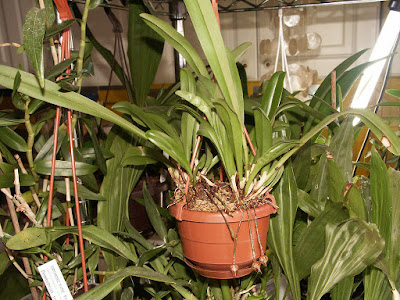Dracula mopsus is native to Ecuador. They grow in the western provinces of Ecuador: Azuay, Cotopaxi, El Oro, Bolívar and Manabí. In the province of El Oro, they are found in dense, wet forests at heights of 1200-1500 m, above Zaruma...
Dracula mopsus also called as The Pug-Like Dracula, Masdevallia mopsus, Masdevallia triceratops, is a species of the genus Dracula. This species was described by Carlyle A. Luer in 1978.
IDENTIFY DRACULA MOPSUS
Dracula mopsus is native to Ecuador. They grow in the western provinces of Ecuador: Azuay, Cotopaxi, El Oro, Bolívar and Manabí. In the province of El Oro, they are found in dense, wet forests at heights of 1200-1500 m, above Zaruma. In the Manabí province, they are found near the top of Montecristi at an altitude of 650 m. In the province of Cotopaxi, they grow west of Corazón, at an altitude of 1200 m.
It is a miniature to small sized, hot to cool growing epiphyte, which reaching 9-20 cm in height, with a very short, 1-3 cm long ramicaul enveloped basally by 2 to 3 acuminate, tubular sheaths and carrying a single, apical, erect, narrowly elliptic, conduplicate below into the petiolate base, 8-17 cm long leaf.
The Pug-Like Dracula blooms in the winter through summer in situ on a pendant, to 15 cm long, bracteate, successively 1, 2 flowered inflorescence that arises from the base of the ramicaul. The flowers are deeply cup-shaped, about 2.5 cm in diameter, and the outer whorls are creamy, with rare dots in red-purple or purple-brown, especially from the base and at the apexes. Each outer whorl petal has a thick, red-brown petiole growing from the apex. The inner whorls are yellow-green and have purple spots. The lip is yellow-orange with pink spots and the prone is white.
DRACULA MOPSUS CARE AND CULTURE
Cultural information should only be used as a guide, and should be to be adapted to suit you. Your physical location; where you grow your plants, how much time you have to devote to their care, and many other factors, will need to be taken into account. Only then can you decide on the cultural methods that best suit you and your plants.
Light:
Dracula mopsus needs a light level of 10000-15000 lux. The light should be filtered or dispersed, and the plants should not be exposed to direct sunlight in the afternoon hours. Strong air movement should be ensured all the time.
Temperature:
It is a plant with moderate thermal requirements. Throughout the year, the average day temperature is 26-28 ° C, and the average night temperature is 17-20 ° C, which gives a daily amplitude of 8-9 ° C.
Humidity:
The Pug-Like Dracula needs the probable average humidity of 75-80% throughout the year.
Substrate, growing media and repotting:
Dracula mopsus must be grown mounted on washers or in openwork hanging baskets with high humidity, and in the summer of daily watering. In the case of such suspended plants, during the dry and hot periods it may be necessary to water several times a day.
You can also use hanging moss-covered sphagnum moss filled with loose, fast-drying ground, such as medium granulation fir bark or chopped tree fern fibers. Also, materials that release the substrate but often retain a part of the moisture are often added to the mixture, for example perlite and cut sphagnum moss. Wood charcoal is also often added to ensure the air permeability of the substrate and protection against acidification.
The plants grown in it must be replanted every 9-12 months. Plants should be replanted when the substrate begins to decompose or grow out of the pots. If replanting is done at the time when new roots begin to appear, the plant will be accepted and rooted in the shortest possible time.
Watering:
The cultivated plants should be watered frequently, but they should be allowed to dry well between waterings.
Fertilizer:
During the active growth, the plants should be fertilized every week 1/4-1/2 of the recommended dose of fertilizer for orchids. You can use balanced fertilizer throughout the year, but also can use fertilizer with increased nitrogen content from spring to mid summer, and then in the late summer and autumn, use a fertilizer with a higher content of phosphorus.
Rest period:
In winter, the amount of water should be slightly reduced, especially if the Dracula mopsus are grown in dark, short days, which occurs in moderate latitudes. However, do not allow them to completely dry out. Fertilization should be reduced until more intense watering starts in the spring.















COMMENTS